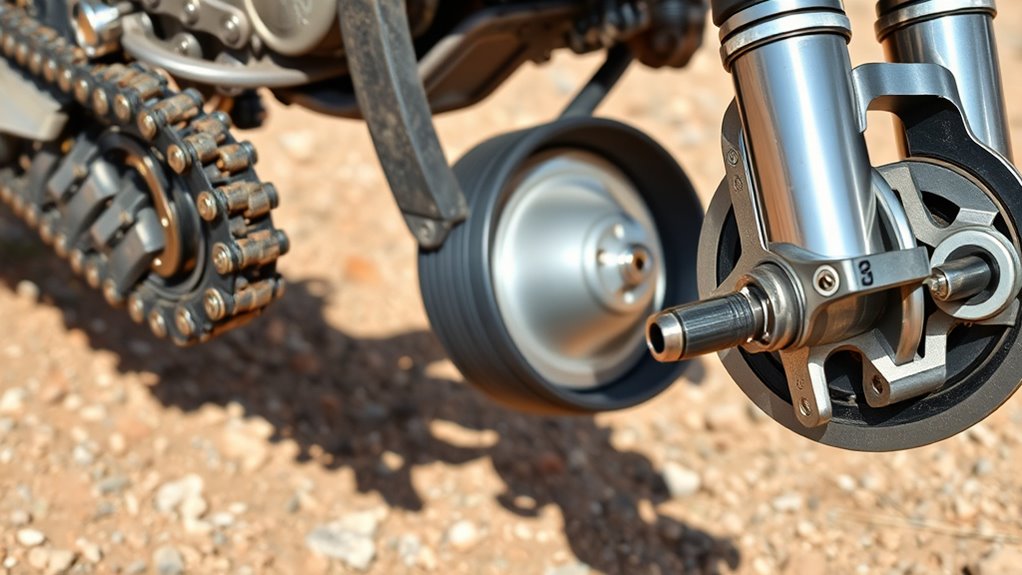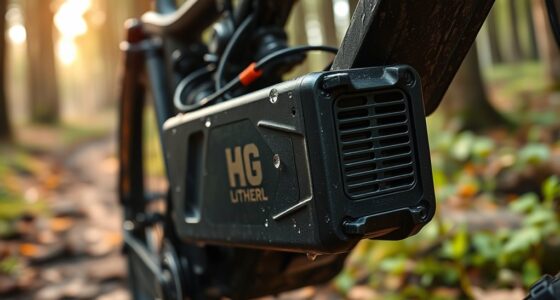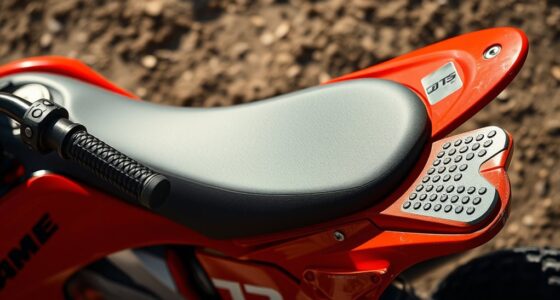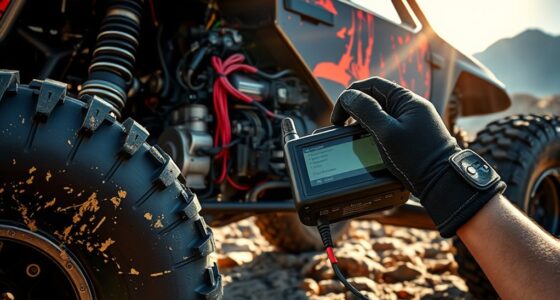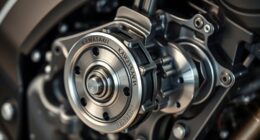When choosing between chain, belt, and shaft drives for off-road speed, your choice impacts acceleration, top speed, and durability. Chain drives provide quick power transfer, giving you responsive acceleration over tough terrain. Belt drives support higher top speeds with smooth operation but can slip in mud. Shaft drives offer durability and steady performance but may be less agile. To understand how each affects your adventures and performance, keep exploring these systems further.
Key Takeaways
- Chain drives provide rapid power transfer, resulting in quicker acceleration suitable for challenging off-road terrains.
- Belt drives support higher top speeds with smoother, quieter operation, enhancing performance on uneven surfaces.
- Shaft drives offer steady, reliable power but generally produce moderate acceleration and top speeds, prioritizing durability.
- Chain systems may experience slip and stretch over time, impacting speed and responsiveness in rugged environments.
- Belt and shaft drives tend to maintain consistent speed better with less maintenance, beneficial for long off-road rides.
How Chain Drives Affect Off-Road Speed and Performance

When it comes to off-road riding, chain drives have a significant impact on speed and performance. They deliver power efficiently from the engine to the wheels, allowing for quick acceleration and responsive handling on rugged terrains. Because chains are lightweight and can be easily maintained or replaced, they excel in environments where durability and adaptability matter. However, chains require regular lubrication and tension adjustments to prevent slippage or damage, especially under rough conditions. When properly maintained, they provide consistent power transfer, helping you navigate steep inclines, loose gravel, or muddy trails with confidence. Their ability to handle high torque and deliver instant throttle response makes them a popular choice among off-road enthusiasts seeking ideal performance. Additionally, incorporating easy-to-maintain components can enhance overall reliability during intense rides.
Belt Drives: Speed Advantages and Limitations on Rugged Terrain
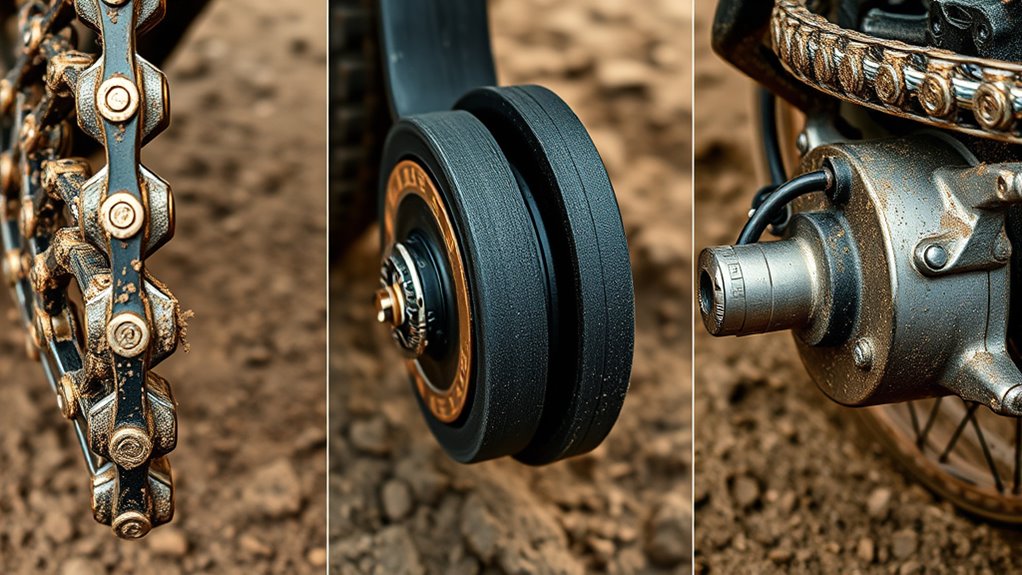
Belt drives offer notable speed advantages due to their smooth and efficient power transfer, which can translate into quicker acceleration and a more responsive ride on rugged terrain. Their design reduces power loss, allowing you to transfer more torque directly to the wheels. This efficiency helps you maintain higher speeds over uneven surfaces. However, belt drives have limitations. They tend to slip under excessive load or mud, which can hinder consistent speed and control. Additionally, belts are sensitive to debris and require regular tension adjustments. While they provide quieter operation and less maintenance than chains, their speed benefits diminish if the terrain becomes too challenging or if the belt isn’t properly maintained. Overall, belt drives enhance speed on moderate rugged terrain but may struggle in extreme conditions. Understanding the different drive types can help you choose the best option for challenging off-road adventures.
Shaft Drives and Their Impact on Off-Road Velocity
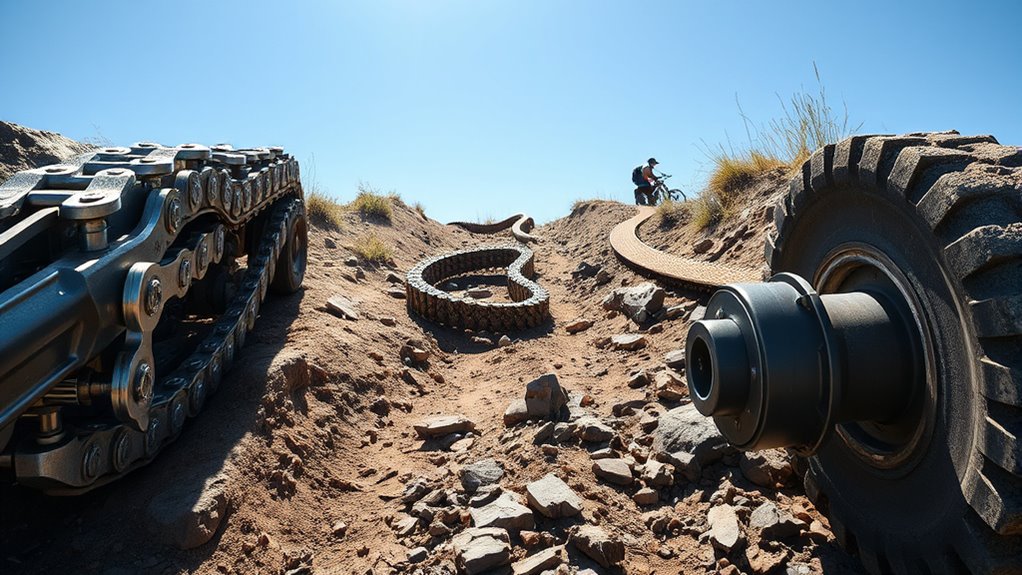
Have you considered how shaft drives influence off-road velocity? Unlike chains or belts, shaft drives are enclosed and require less maintenance, which keeps your focus on riding rather than repairs. This design offers smoother power delivery, helping you maintain steady speed over rough terrain. However, shaft drives are typically heavier and less efficient at transferring power, which can slightly slow you down compared to other systems. The added weight also impacts handling, especially on steep inclines or technical trails. Nonetheless, their durability and low maintenance mean less downtime, allowing you to stay on the trail longer. Additionally, the color accuracy of the drivetrain components can influence overall performance and reliability. Overall, shaft drives tend to favor reliability over outright speed, making them a solid choice if you prioritize consistent performance in challenging off-road conditions.
Comparing Power Transfer Efficiency Among the Three Systems
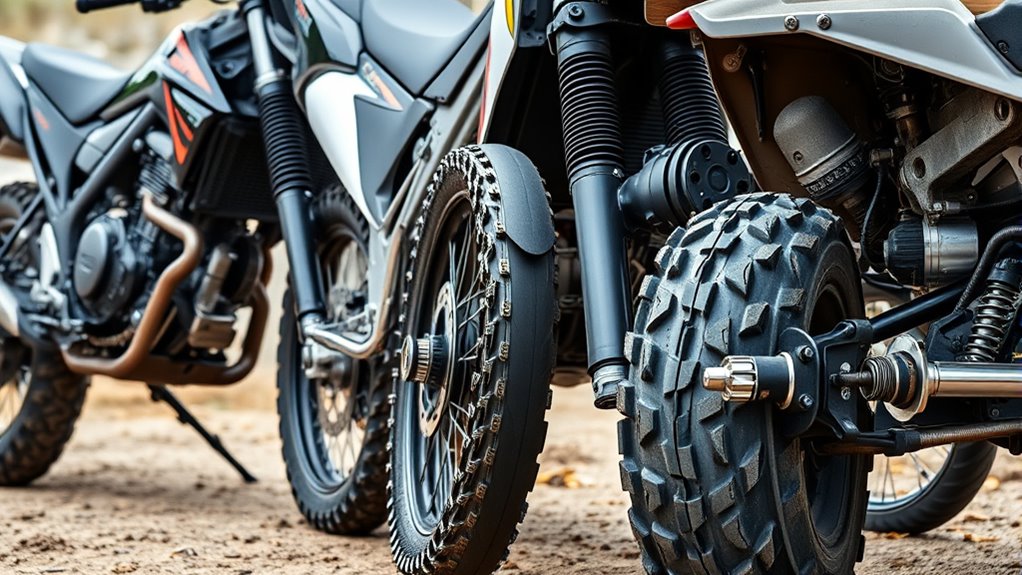
Among the three drive systems, chain drives typically transfer power more efficiently than belt or shaft drives. This efficiency means less energy loss and more immediate response when you hit the throttle, giving you a confident, connected feeling on rough terrain. Chain drives are designed for maximum power transfer, making every engine revolution count, especially when climbing steep inclines or maneuvering tricky trails. Additionally, their rustic charm and durability make them a popular choice for rugged off-road use.
Durability and Speed Retention in Challenging Conditions
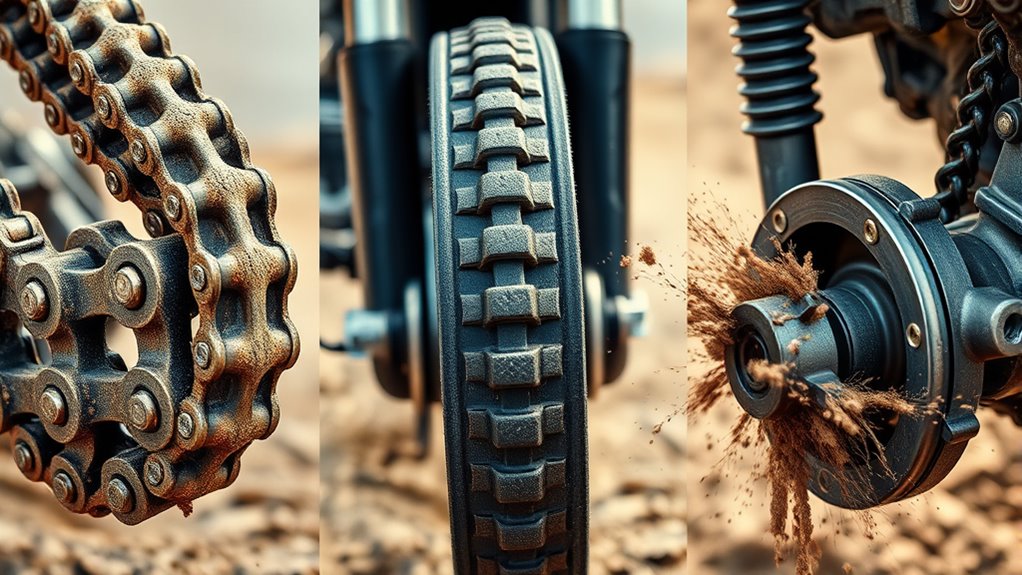
When riding through mud and rough terrain, you’ll notice some systems handle wear better than others. Over time, power loss can become an issue, especially if the drive components aren’t resistant to harsh conditions. Understanding how each system maintains speed and durability can help you choose the best option for tough environments.
Wear Resistance in Mud
In muddy conditions, wear resistance becomes essential for maintaining both durability and speed. When mud clings to your drive system, it can accelerate wear and reduce performance. A robust drive system resists this harsh environment, helping you stay ahead. With the right setup, you avoid slowdowns caused by debris and prolong your equipment’s lifespan. Imagine confidently powering through thick mud without worrying about breakdowns or losing momentum. The key is choosing a system designed to withstand abrasive grit and constant exposure to moisture. Incorporating data-driven marketing strategies can help you identify the best drive systems that meet these tough conditions.
- Feel the thrill of tackling tough terrain without hesitation.
- Trust your drive to keep up, mile after muddy mile.
- Maintain your speed and confidence, no matter how messy the trail gets.
Power Loss Over Time
Over time, power loss can considerably impact your drive system’s ability to maintain speed and performance in tough conditions. Chain drives tend to experience more slip and stretch, leading to gradual power reduction, especially after prolonged use. Belt drives generally retain their tension better but can weaken or crack under extreme stress, causing slight efficiency drops. Shaft drives are the most durable, with minimal loss over time, thanks to enclosed components that resist dirt and debris. However, even shaft drives can experience minor wear that reduces efficiency. Environmental factors like mud, dust, and moisture accelerate wear in all types, increasing power loss. Regular maintenance ensures your drive system stays efficient longer, helping you keep consistent speed in challenging off-road conditions. Additionally, tuning modifications can help optimize overall drive efficiency and reduce power loss during demanding rides.
Maintenance Requirements and Their Influence on Off-Road Readiness
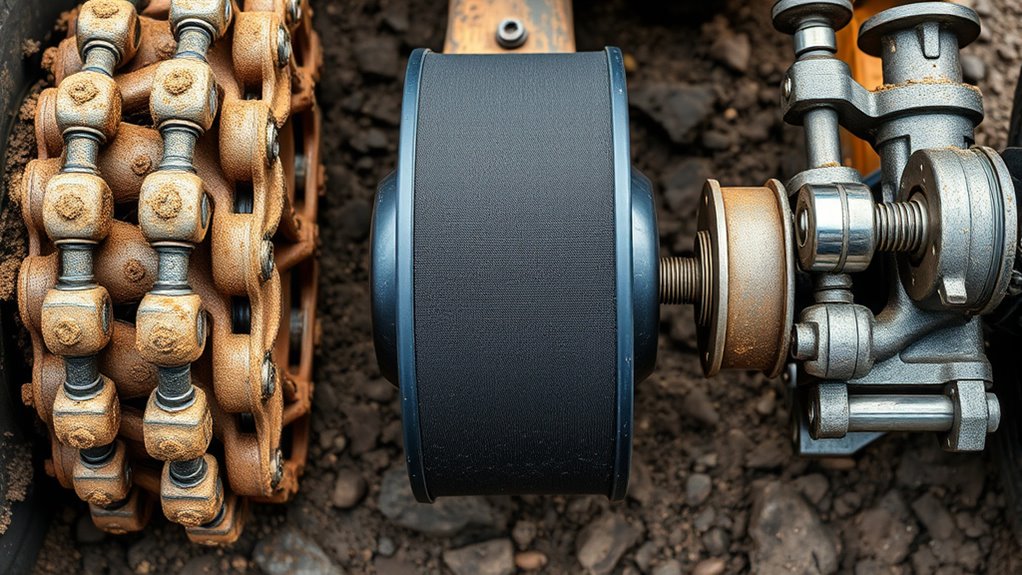
Maintenance requirements substantially impact an off-road vehicle’s readiness, as each drive system demands different levels of upkeep to perform reliably in tough conditions. A chain drive requires frequent lubrication, cleaning, and tension adjustments to prevent failures. Belt drives need regular inspections for tears or cracks, with replacements more common in rough terrain. Shaft drives are the most low-maintenance, but still need periodic fluid checks and minor adjustments to stay in top shape. Neglecting maintenance can lead to breakdowns, delays, and compromised safety. Staying on top of upkeep means you’re ready for anything the trail throws at you. Proper brand reputation and adherence to recommended maintenance schedules are crucial for ensuring your vehicle’s optimal performance and longevity.
- Experience the thrill of a reliable ride, knowing your drive system won’t let you down.
- Avoid unexpected breakdowns that cut your adventure short.
- Keep your vehicle in prime condition, conquering even the toughest terrain with confidence.
Weight Differences and Their Effect on Speed and Handling

The weight of your drive system can considerably impact your bike’s speed and handling. Lighter components allow for quicker responses and better maneuverability, giving you an edge on the road or trail. Understanding how weight differences influence performance helps you choose the best drive system for your riding style.
Lighter Components, Faster Response
Have you ever noticed how lighter components in a drive system can make a noticeable difference in a motorcycle’s responsiveness? When you reduce weight, your bike reacts more quickly to your throttle inputs, making every maneuver feel sharper and more intuitive. Lighter parts mean less inertia, so acceleration feels immediate, and you can adjust your speed with precision. This agility is especially crucial off-road, where quick reactions can mean the difference between conquering a trail or getting stuck. Imagine feeling confident in your control, knowing that every ounce of weight saved enhances your performance.
- Experience faster throttle response that keeps you ahead of the terrain
- Feel the power transfer more efficiently, boosting acceleration
- Enjoy improved handling, making tight turns and quick maneuvers effortless
Handling Balance and Weight
When lighter components improve throttle response and acceleration, they also influence how your motorcycle handles overall. Reducing weight, especially around the drive system, shifts the handling balance, making your bike more agile and responsive off-road. A lighter drive train decreases unsprung mass, allowing better suspension action and improved traction. This means sharper turn-in, quicker steering, and less fatigue on rough terrain. Conversely, heavier drives add stability at higher speeds but can make maneuvering more sluggish. Your choice of drive type impacts weight distribution, affecting front-to-rear balance. A heavier shaft drive, for example, shifts weight backward, potentially reducing front-end agility. Ultimately, understanding how weight differences influence handling helps you optimize your bike’s performance for off-road conditions. Additionally, selecting appropriate drive systems can further enhance handling characteristics based on your riding style and terrain.
Flexibility and Adaptability to Varied Terrain Types
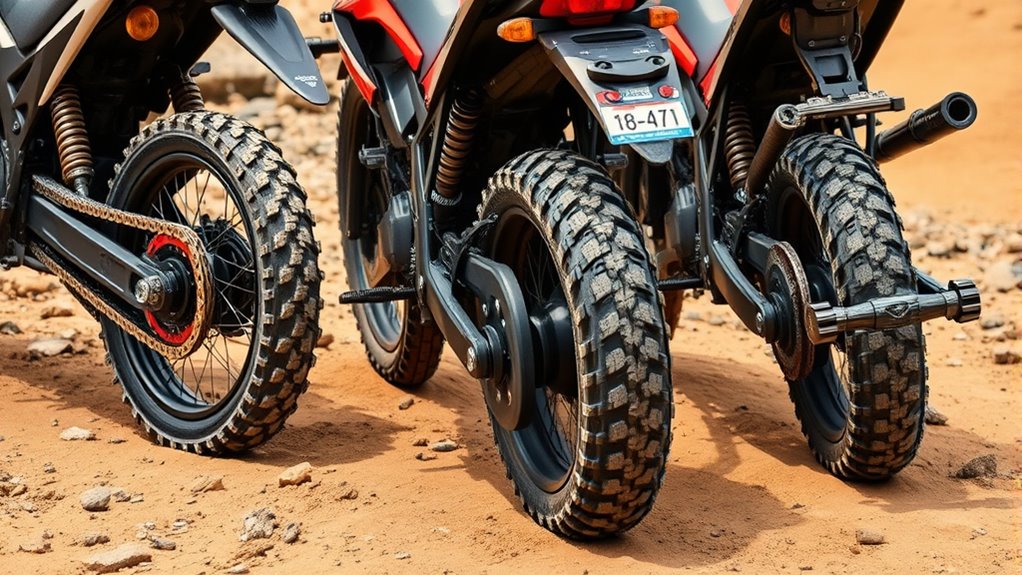
Choosing the right drive system can considerably impact how well your vehicle handles different terrains. Your choice affects flexibility and adaptability, especially when maneuvering through rough or unpredictable surfaces. Chain drives excel on challenging off-road trails, offering durability and resilience against dirt and debris. Belt drives provide smoother operation and quieter rides, making them ideal for varied terrain where comfort matters. Shaft drives, with their enclosed design, adapt well to changing conditions, requiring less maintenance and reducing vulnerability. Additionally, some drive systems incorporate fabric decorating markers to customize and personalize vehicle accessories for a unique look.
- Feel confident tackling rocky paths without fear of failure
- Experience smooth, controlled rides across uneven ground
- Trust your vehicle to handle muddy, sandy, or rugged landscapes with ease
Impact of Drive Systems on Acceleration and Top Speed

The type of drive system you choose considerably influences your vehicle’s acceleration and top speed. Chain drives typically deliver quick power transfer, boosting acceleration, but can be less smooth at high speeds. Belt drives offer smoother operation, helping maintain consistent top speeds, though they may slightly limit rapid acceleration. Shaft drives prioritize durability and stability, often resulting in moderate acceleration and top speeds but excel in off-road reliability.
| Drive System | Acceleration | Top Speed |
|---|---|---|
| Chain | Fast | Moderate to high |
| Belt | Moderate | High |
| Shaft | Steady | Moderate |
Real-World Off-Road Performance: Case Studies and Rider Experiences
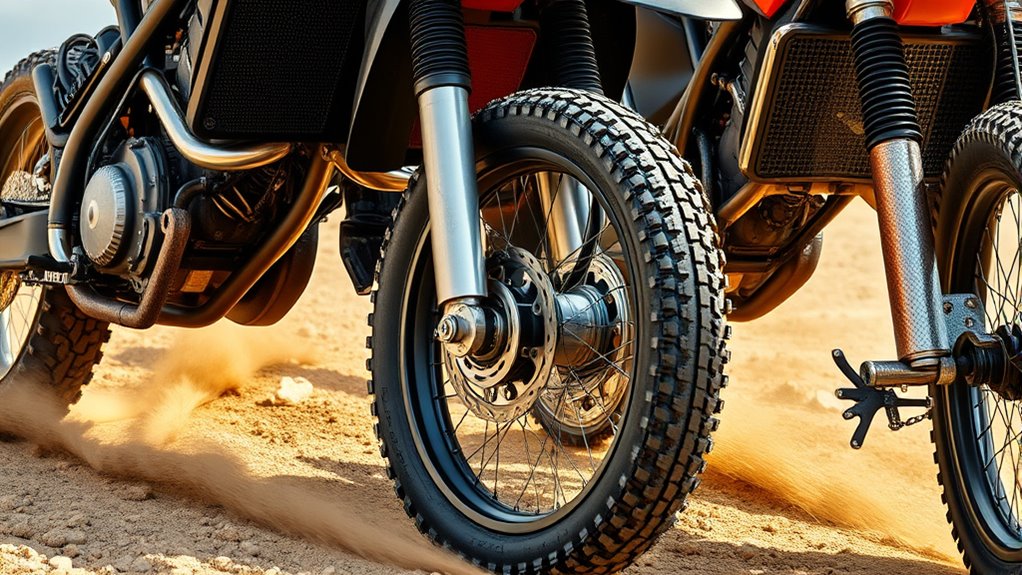
Real-world off-road riding reveals how different drive systems perform under tough conditions. You’ll notice the chain drive’s resilience on rocky trails, offering quick repairs and reliable power transfer. Belt drives, praised for their quiet operation and low maintenance, shine on smooth, muddy paths but can struggle with debris. Shaft drives provide unmatched durability and cleanliness, making them ideal for long, muddy rides where minimal upkeep matters. Additionally, GMC tuning techniques can optimize vehicle performance, ensuring your drive system functions at its best in challenging terrains.
Different off-road drive systems excel in various conditions—chain, belt, and shaft drives each offer unique advantages.
- Experience the thrill of seamless power delivery with a chain, even in harsh terrain.
- Feel confident knowing a belt drive keeps noise down while tackling muddy tracks.
- Trust a shaft drive to handle the toughest conditions, reducing your worries about maintenance.
Your choice impacts how confidently you conquer off-road challenges, shaping your riding adventures every time.
Frequently Asked Questions
Which Drive System Offers the Best Off-Road Traction?
When considering off-road traction, your choice of drive system markedly impacts performance. You’ll find that shaft drives generally provide the best traction because they’re rugged and require less maintenance, making them ideal for rough terrains. Chains, while offering excellent grip and power transfer, can slip or jump under extreme conditions. Belts are lighter but may slip more easily. Overall, shaft drives give you the most reliable traction off-road.
How Do Drive Systems Affect Motorcycle Maneuverability Off-Road?
You’ll find that drive systems markedly impact your motorcycle’s off-road maneuverability. Chain drives offer quick power transfer and are lightweight, helping you navigate tight trails with agility. Belt drives provide smoother, quieter rides, but may be less durable off-road. Shaft drives are low maintenance and stable, but can be heavier, which might affect handling on rough terrain. Your choice influences how easily you can steer, accelerate, and control your bike off-road.
Are There Environmental Impacts Influencing Drive System Choices?
You should consider how environmental impacts influence your drive system choice. For example, chains require regular lubrication and can shed debris, affecting the environment. Belts are cleaner but may not handle mud and dirt well. Shaft drives are low-maintenance and environmentally friendly, producing less waste and requiring fewer replacements. Your decision depends on balancing maintenance needs, environmental impact, and off-road conditions to choose the most sustainable and reliable system.
How Do Drive Systems Perform in Muddy or Sandy Conditions?
Imagine your ride as a determined explorer wading through mud and sand. A chain drive bites into gritty terrain, offering raw power but risking dirt build-up. Belt drives glide smoothly, resisting mud but sometimes slipping in loose sand. Shaft drives, like sturdy anchors, handle tough conditions with less fuss, but may transfer power a bit more slowly. Your choice impacts grip, durability, and ease—think about what terrain you’ll conquer most.
Can Drive System Modifications Improve Off-Road Speed?
You can definitely improve off-road speed with drive system modifications. Upgrading to a more efficient drive system reduces power loss and enhances traction, allowing you to tackle tricky terrains faster. Consider installing a high-quality chain, belt, or shaft drive designed for rough conditions. Regular maintenance and upgrading components like sprockets or pulleys also boost performance. These tweaks help you gain better control and speed, making off-road adventures more exciting.
Conclusion
Choosing the right drive system is like picking the perfect gear for your adventure; it shapes how smoothly and swiftly you navigate rugged trails. Chain drives offer raw speed but require more maintenance, while belt drives keep things quiet and efficient. Shaft drives provide durability but may slow you down slightly. Weigh your terrain and riding style carefully—your ideal drive system will be the steady compass guiding your off-road journey.
